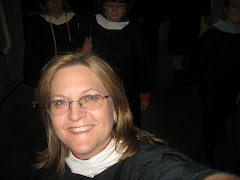This title is one of my favorite scenes from the movie Hook with Robin Williams. As a child looks at the face of the grown up Peter Pan he can't see any resemblance to the Peter Pan he knows or at least thinks he should see. But, with careful examination (actually he holds Peter's face in his two hands and manipulates it this way and smooshes it that way...) he finally sees that Peter is actually in there. He stops being suspicious of Peter and just loving the old Peter the way he loved the Peter he knew. The Ayers chapter this week struck a chord with this idea of really looking deep and thoughtfully at our students to try to see the person inside behind the skin of behaviors and abilities.
Ayers talked about the limiting factor of all the labels we use in the schools today. Do these labels really tell us much of anything about who our student really is as a person, or what they need to learn well or more important to feel viable and appreciated for who they are? The labels, Ayers tells us only speak of what the students can not do not what they can do.
I really like some of Mr. Ayers ideas for getting to know his students. I have seen the use of self descriptinve poetry before, but thought of it only from the perspective of helping students become more aware of themselves. I can see how really studying these as windows to the child could be helpful. Examining a childs hopes and fears would help us develop a sense of compassion for even the most exhausting of our charges.
To journal about each student in class would seem like a daunting task. I can see how the value of this tool could help identify patterns in behavior and force us to watch and listen to what our students are doing and saying. I journalled for all my own children and found it helped me to not only remember the moments but also to put things in their life in perspective. It also gave me a sense of humor about some of their foibles too. I think in the classroom a chart could be used to make small notations on a daily basis to evaluate maybe weekly to gain a better understanding of the bigger picture of who these children are and how they are best learning.
As Ayers tells us, a teacher needs to be part detective part researcher and part puzzle master to understand what makes kids tick and to learn ourselves how to best serve them. As I pondered this during the day, I had a novel thought. What if the schools provided summer daycare programs manned by the same teachers that would be in their classrooms in the fall. Wouldn't it be interesting to have the luxury of knowing our students ahead of time? We could just observe them at play and in their interactions without the pressure of having to accomplish teaching and learning. We could start our school year with such an understanding of who they are and what makes them tick. I guess that would be the benefit of looping with kids though several grades.
This reading really encouraged me to remember to value each child as they are and look for the positve qualities in each of them. Listen to what the kids are saying to you and others about who they are. Most importantly to be an observer in the classroom looking for the ways in which each student is unique and value them all individually.
Subscribe to:
Post Comments (Atom)

Nice idea, to have time to observe children informally and at play before starting formal work with them. What if it wasn't in summer, but at the start of the school year? Could we make up the time if we knew that we were being more effective with each child in the end?
ReplyDeleteJournaling can be time-consuming. We can watch a few kids at a time -- because knowing only a few children deeply will help to see all of them more deeply. We can take photographs. We can record some classroom activities (as Vivian Paley does) and listen later when things are less hectic.
And we can design many more assignments that invite the child to show us how he or she is.
And yes, most important of all is the constant acknowledgment that we don't know and may be misunderstanding and always have more to learn...